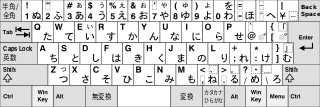 W
WVolume 1 of the Association of Radio Industries and Businesses (ARIB) STD-B24 standard for Broadcast Markup Language specifies, amongst other details, a character encoding for use in Japanese-language broadcasting. It was introduced on 1999-10-26. The latest revision is version 6.3 as of 2016-07-06.
 W
WJapanese Braille is the braille script of the Japanese language. It is based on the original braille script, though the connection is tenuous. In Japanese it is known as tenji (点字), literally "dot characters". It transcribes Japanese more or less as it would be written in the hiragana or katakana syllabaries, without any provision for writing kanji.
 W
WFlag semaphore is a semaphore system conveying information at a distance by means of visual signals with hand-held flags, rods, disks, paddles, or occasionally bare or gloved hands. Information is encoded by the position of the flags; it is read when the flag is in a fixed position. Semaphores were adopted and widely used in the maritime world in the 19th century. It is still used during underway replenishment at sea and is acceptable for emergency communication in daylight or using lighted wands instead of flags, at night.
 W
WIn relation to the Japanese language and computers many adaptation issues arise, some unique to Japanese and others common to languages which have a very large number of characters. The number of characters needed in order to write in English is quite small, and thus it is possible to use only one byte (28=256 possible values) to encode each English character. However, the number of characters in Japanese is many more than 256 and thus cannot be encoded using a single byte - Japanese is thus encoded using two or more bytes, in a so-called "double byte" or "multi-byte" encoding. Problems that arise relate to transliteration and romanization, character encoding, and input of Japanese text.
 W
WJIS X 0201, a Japanese Industrial Standard developed in 1969, was the first Japanese electronic character set to become widely used. It is either a 7-bit encoding or an 8-bit encoding, although the 8-bit form is dominant for modern use. The full name of this standard is 7-bit and 8-bit coded character sets for information interchange (7ビット及び8ビットの情報交換用符号化文字集合).
 W
WJIS X 0213 is a Japanese Industrial Standard defining coded character sets for encoding the characters used in Japan. This standard extends JIS X 0208. The first version was published in 2000 and revised in 2004 (JIS2004) and 2012. As well as adding a number of special characters, characters with diacritic marks, etc., it included an additional 3,625 kanji. The full name of the standard is 7-bit and 8-bit double byte coded extended KANJI sets for information interchange .
 W
WMojikyō, also known by its full name Konjaku Mojikyō , is a character encoding scheme. The Mojikyō Institute , which publishes the character set, also published computer software and TrueType fonts to go along with it. The Mojikyō Institute, chaired by Tadahisa Ishikawa (石川忠久), originally had its character set and related software and data redistributed on CD-ROM by Kinokuniya. Conceptualized in 1996, the first version of the CD-ROM was released in July 1997. For a time, it offered a web subscription, "Mojikyō WEB" (文字鏡WEB) which had more up-to-date characters.